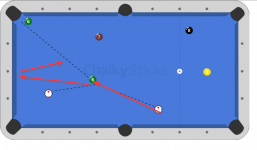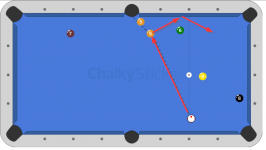Not an instructor, but if we assume your stroke is reliable and the shots are accurately drawn in the diagram, what strikes me about these angles are that they are near the maximum throw angle.
If you normally avoid slow-roll, your instinctive aim may have betrayed you on these two shots.
Throw is greatest with stun. With a rolling cue ball or a shot with english, throw effect decreases as shot speed increases, so it will have the greatest effect with slow-rolling cuts around around the angles you illustrated.
Now, the normal way I would play the five in the diagram would be a slow speed shot with left english to come off the rail away from the 6 to leave more space, and the combination of slow speed and inside spin could well throw the 5 where you indicated. But since you didn't mention using sidespin, I'll assume the way you would ordinarily play that shot if you weren't slow-rolling it would be to go across the table and back for the 6. It may be that the difference in speed between trying to slow-roll it and leave it on the rail rather than going across the table and back two rails affected the amount of throw enough that the 5 hit on the point rather than falling.
On the 6, I can see that if you weren't slow rolling, a good option for getting shape on the 7 would be to stun the 6 in, bounce the CB two rails around the corner pocket and it would come at the 7 in line with the side pocket. If have you a habit of playing shots like that that you may subconsciously aim expecting the 6 to be thrown into the pocket. But a slow rolling shot will have less throw than a stun shot, and that difference could cause the 6 to overcut and hit where you indicated.
Particularly if your set of balls hasn't been cleaned at all and/or it's a very humid environment, this could make throw effect big enough to upset some of these shots you'd normally pocket.
But (and do not take this the wrong way as we all constantly work on our strokes) the more plausible explanation is that since you're not used to slow rolling, your stroke mechanics and feel for your cue delivery may make your cueing a little unsteady when you're trying to baby a shot, and this would hurt you especially on slow-rolls because that's where unintended sidespin will have the greatest effect on the path of the cue ball, causing you to miss your point of aim by just enough to dog the shot. You can think you have your stroke mechanics nailed down because your particular stroking form results in a smooth cue delivery with medium and even very hard shots, but maybe isn't suited (yet) to hitting cleanly with slow shots.
Watch Mosconi Cup videos when they zoom in on the tips of the players cueing at the ball, you'll notice the Americans' tips typically wander all over the place while they're getting ready to hit, yet on 99% of shots they nail it. Many American players have a loose flowing stroke that works best at medium to fast speed and lets them hit big shots with stun and draw without tensing up and are really good at that part of the game. If you watch the Europeans' tips when they're hitting the ball on the other hand, the tip travels in a perfectly straight line in every practice stroke and in their final stroke. It's a more rigid and technical form and in a lot of places you may not notice a real advantage to it,but it holds up better under pressure and with delicate slow speed follows. The Europeans embarrassed team USA last year and many of those matches were lost and won because the Europeans were that much better with their delicate touch shots under pressure, tying up balls in short safeties.
Do you close-bridge? One thing I've had to catch myself with is that when I'm having to hit a slow roll with a slight touch, I start to relax my bridge, which is a big no-no and can cause my tip contact to be a little off. Always keep a firm bridge! I can't say for sure whether a firmer or more delicate grip/cueing arm works better for little baby shots, and I suspect it depends on your form and cue weight, but if have to relax your grip and cueing arm for a delicate shot, do not make the mistake of also relaxing your bridge. What's that saying about not letting the left hand know what the right hand is doing?

